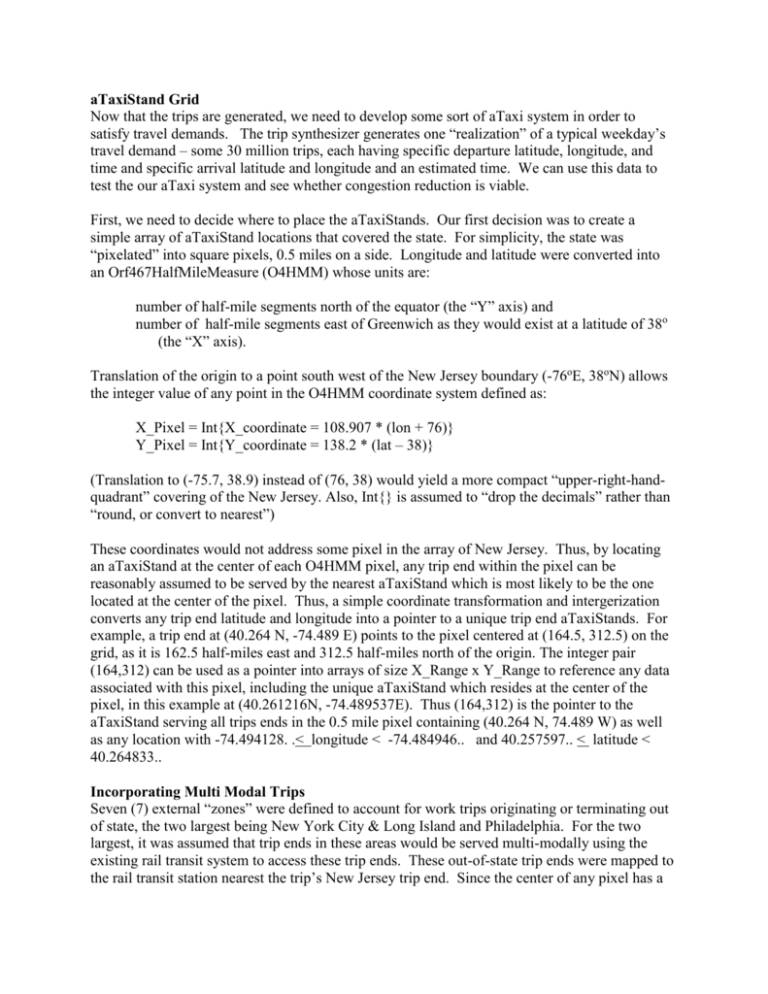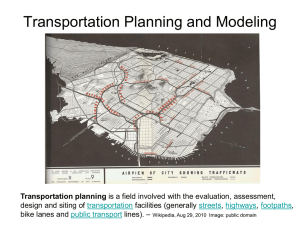aTaxi Design
advertisement

aTaxiStand Grid
Now that the trips are generated, we need to develop some sort of aTaxi system in order to
satisfy travel demands. The trip synthesizer generates one “realization” of a typical weekday’s
travel demand – some 30 million trips, each having specific departure latitude, longitude, and
time and specific arrival latitude and longitude and an estimated time. We can use this data to
test the our aTaxi system and see whether congestion reduction is viable.
First, we need to decide where to place the aTaxiStands. Our first decision was to create a
simple array of aTaxiStand locations that covered the state. For simplicity, the state was
“pixelated” into square pixels, 0.5 miles on a side. Longitude and latitude were converted into
an Orf467HalfMileMeasure (O4HMM) whose units are:
number of half-mile segments north of the equator (the “Y” axis) and
number of half-mile segments east of Greenwich as they would exist at a latitude of 38o
(the “X” axis).
Translation of the origin to a point south west of the New Jersey boundary (-76oE, 38oN) allows
the integer value of any point in the O4HMM coordinate system defined as:
X_Pixel = Int{X_coordinate = 108.907 * (lon + 76)}
Y_Pixel = Int{Y_coordinate = 138.2 * (lat – 38)}
(Translation to (-75.7, 38.9) instead of (76, 38) would yield a more compact “upper-right-handquadrant” covering of the New Jersey. Also, Int{} is assumed to “drop the decimals” rather than
“round, or convert to nearest”)
These coordinates would not address some pixel in the array of New Jersey. Thus, by locating
an aTaxiStand at the center of each O4HMM pixel, any trip end within the pixel can be
reasonably assumed to be served by the nearest aTaxiStand which is most likely to be the one
located at the center of the pixel. Thus, a simple coordinate transformation and intergerization
converts any trip end latitude and longitude into a pointer to a unique trip end aTaxiStands. For
example, a trip end at (40.264 N, -74.489 E) points to the pixel centered at (164.5, 312.5) on the
grid, as it is 162.5 half-miles east and 312.5 half-miles north of the origin. The integer pair
(164,312) can be used as a pointer into arrays of size X_Range x Y_Range to reference any data
associated with this pixel, including the unique aTaxiStand which resides at the center of the
pixel, in this example at (40.261216N, -74.489537E). Thus (164,312) is the pointer to the
aTaxiStand serving all trips ends in the 0.5 mile pixel containing (40.264 N, 74.489 W) as well
as any location with -74.494128. .< longitude < -74.484946.. and 40.257597.. < latitude <
40.264833..
Incorporating Multi Modal Trips
Seven (7) external “zones” were defined to account for work trips originating or terminating out
of state, the two largest being New York City & Long Island and Philadelphia. For the two
largest, it was assumed that trip ends in these areas would be served multi-modally using the
existing rail transit system to access these trip ends. These out-of-state trip ends were mapped to
the rail transit station nearest the trip’s New Jersey trip end. Since the center of any pixel has a
nearest rail station, which itself exists in a unique pixel, it is straight forward to populate a pixel
array with the pixel pointers to the nearest rail station. Thus direct indexing into this
NearestRailStation array transforms the NYC or PHL trip end to the nearest rail station.
Transformation of trip end times requires a little more work. For trips originating in New Jersey
their arrival time is taken simply as the existing departure time plus the travel time to the station.
(For simplicity in this analysis travel times were taken as simply the “Manhattan Distance” (onehalf the sum of the absolute values of the differences in half mile coordinates) divided by 30mph.
A better estimate would be to first update the departure time based on a train frequency at the
departure train station. The NJ trip end departure would be made earlier by the amount of time
since the departure of the last train prior to the previously computed station arrival time plus a
randomly drawn amount of time that reflects the individual traveler’s risk aversion to missing the
previous departure. This modification of the original departure time would manifest the kind of
arrival congestion that tends to occur preceding the departure of a train. ). For trips originating
in NYC or PHL, trains to New Jersey were assumed to leave on the half hour throughout the day,
except trips from NYC destined to rail stations in Hudson, Essex and Union counties. For these
a 15 minute frequency was assumed. Arrival times at the station nearest the New Jersey
destination was assumed to be the existing departure time moved up to the next departing train,
the next half hour plus the travel time for the Manhattan Distance between NYC/PHL and the
train station nearest the New Jersey destination. This arrival time becomes the departure time for
the ensuing aTaxi trip. This process should yield the realistic clustering of demand for aTaxi
service at train stations as trains arrive. The expected destination arrival time is then updated
using the aTaxi expected travel time (= ManhattanDistance/30mph).
At this point only trips to/from NYC and PHL use the rail system; however, it is rather straight
forward to identify trips that could be well served multi-modally. These are trips for which one
trip end is in a pixel that contains a train station. (If both trip end pixels have rail stations then
the entire trip is made by rail; unless the Manhattan Distance between these pixels is, say more
than 50%, greater than the sum of the Manhattan Distance between the origin and destination
pixels via the Lautenberg Station in Secaucus). Each of these trips could be assigned to be
served via the train station nearest the non-rail trip end, with aTaxi departure and arrival times
updated as is done with trips having an end in NYC or PHL.
Volumes and RideShare Analysis
With the trips now available and adjusted for multi modal transportation, analysis can be done
for
a) volumes
b) rideshare potential
for different levels of stratification
a) pixel
b) county
c) state
This ORF 467 class split up the trips by origination county and assumed responsibility for
several originating counties each. For the trips originating in each county, the trips can be
sorted by origination pixel and time to parse the origination data over time for each pixel. This
allows origination volume information to be gathered and analyzed. For instance, the class can
track which pixels had highest number of intrapixel trips, walk trips, or potential taxi trips for a
given time period. This can also be done with destination pixels and time as well to ascertain the
total travel behavior of a particular area over time.
From here, the travel data can be used to simulate the aTaxis and actually make the trips to
determine rideshare potential. In this simulation, there are aTaxis at each pixel that wait for
passengers to arrive according to departure data in the trip synthesizer. For a particular pixel,
each passenger with a particular destination gets in a car. Once this passenger enters the car, a
Departure Delay counter (which is pre-specified by the program and is uniform throughout the
entire simulation) is activated and the car will be set to depart after that delay (e.g. 2 minutes) has
passed. However, if another passenger arrives with the same destination with the specified
Departure Delay time, that passenger enters the existing aTaxi and the occupancy attribute of
that aTaxi is incremented. We repeat this process for the entire county’s pixels until all trips
have been made. Rideshare analysis can then be done by looking at average vehicle occupancy
𝐴𝑣𝑒𝑟𝑎𝑔𝑒 𝑉𝑒ℎ𝑖𝑐𝑙𝑒 𝑂𝑐𝑐𝑢𝑝𝑎𝑛𝑐𝑦 =
𝑁𝑢𝑚𝑏𝑒𝑟 𝑜𝑓 𝑇𝑟𝑎𝑣𝑒𝑙𝑒𝑟𝑠
𝑁𝑢𝑚𝑏𝑒𝑟 𝑜𝑓 𝐷𝑒𝑝𝑎𝑟𝑡𝑒𝑑 𝑎𝑇𝑎𝑥𝑖𝑠
Or the ratio of the miles a person demanded1 to actual miles driven by taxi
𝑃𝑒𝑟𝑠𝑜𝑛 𝑇𝑟𝑖𝑝 𝑀𝑖𝑙𝑒𝑠
𝑎𝑇𝑎𝑥𝑖 𝑇𝑟𝑖𝑝 𝑀𝑖𝑙𝑒𝑠
In this analysis, an additional passenger would only enter the vehicle if it were destined to the
same destination (pixel). An additional analysis would permit circuity; if the next traveler to
arrive at the taxi stand did not add 20% extra circuity (in Manhattan Distance) to either
individual’s trip, then the share would be permitted. This, theoretically, should permit more
rideshares.
What’s ahead
In the subsequent pages, the analysis for each county will be presented.
1
This is the original distance from origin to destination, NOT the amount serviced by taxi. We look at this original
data to determine the original demand that was serviced.







